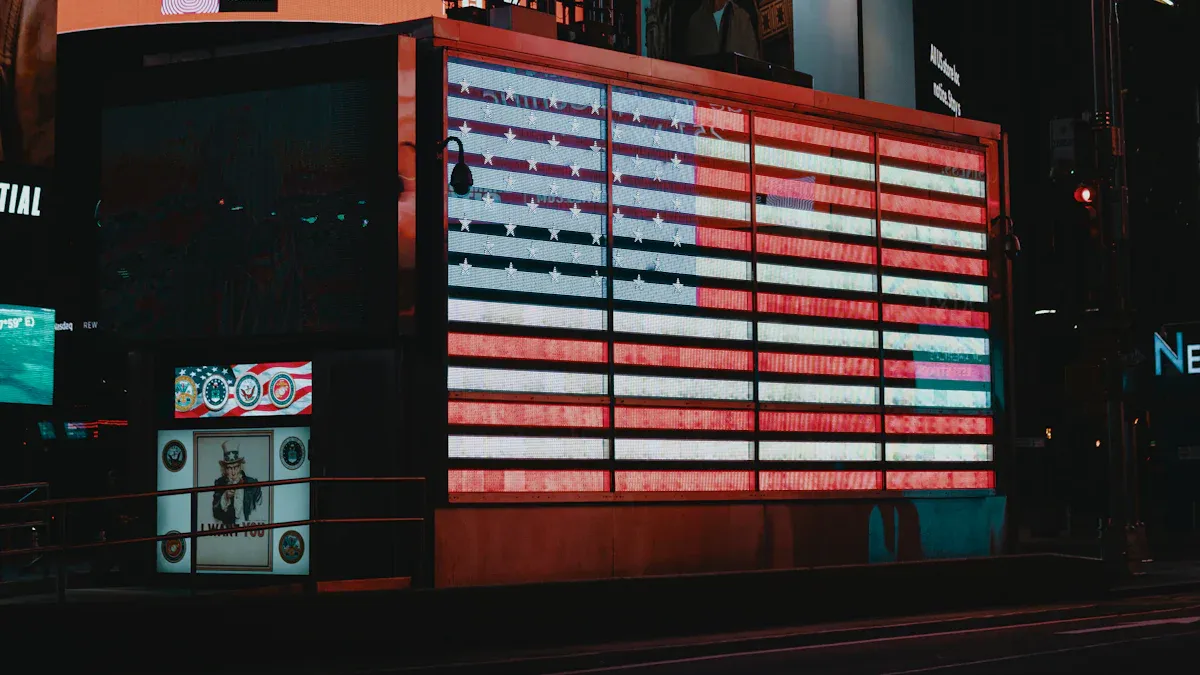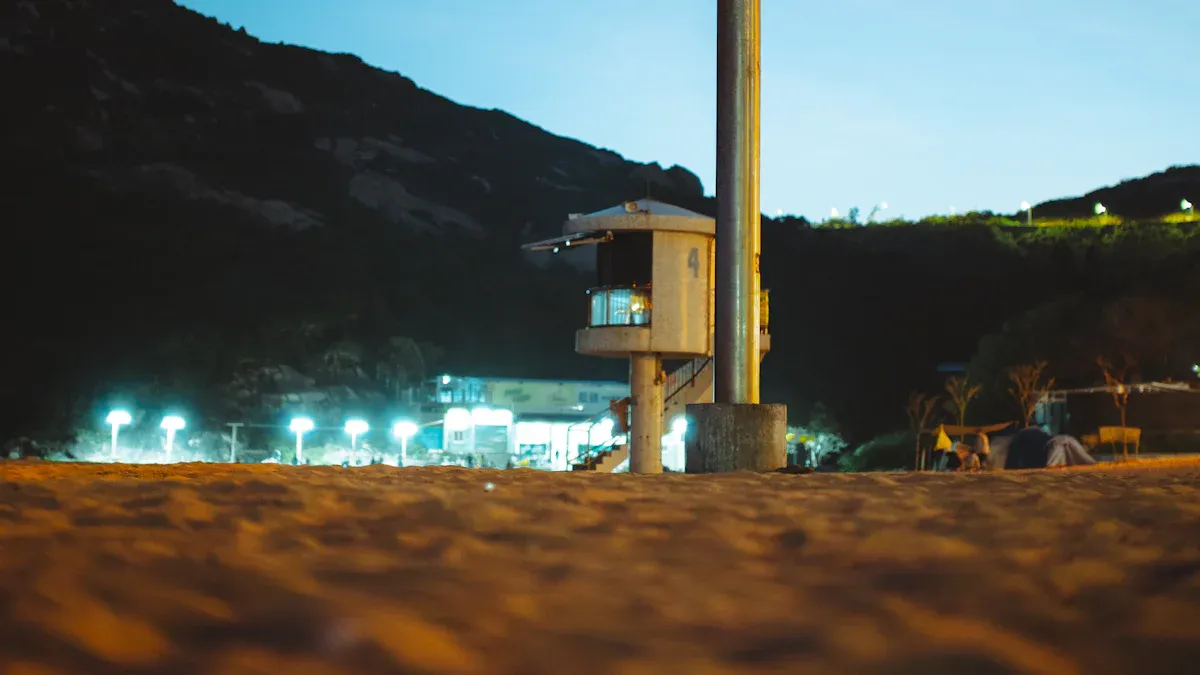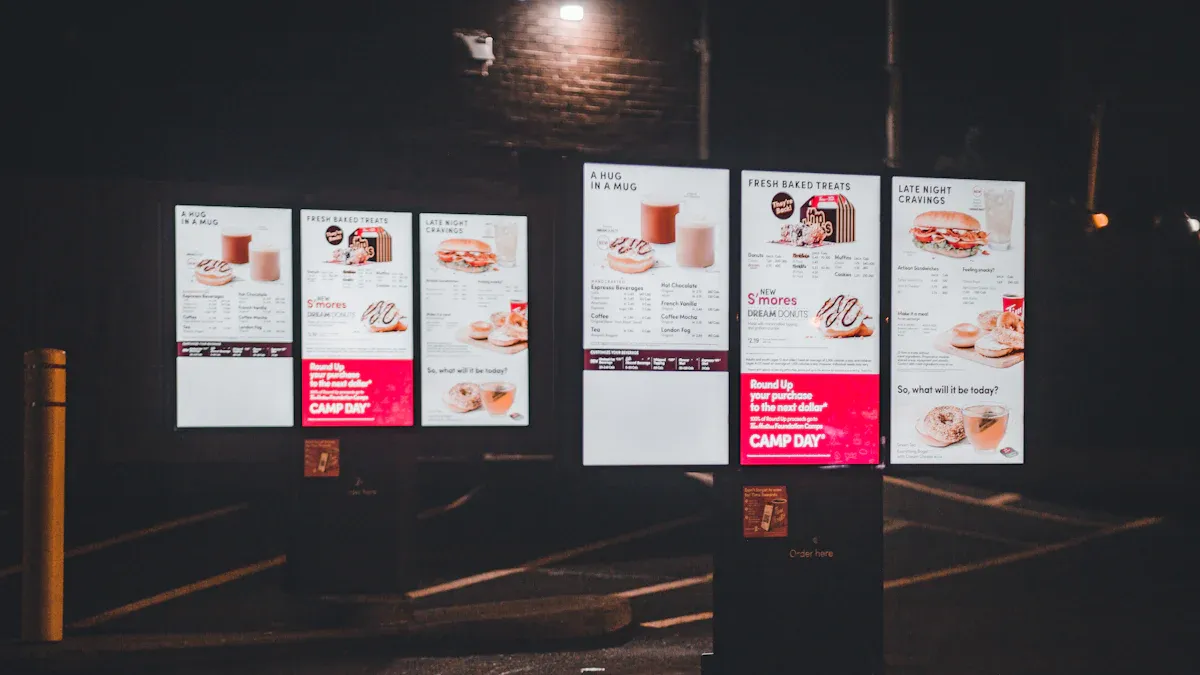Weatherproof Outdoor Display Cases: Protecting Your Digital Signage in All Environments

You need strong protection for your digital signs in every environment. Weatherproof Outdoor Display Cases help keep your screens safe from many dangers, such as:
Heavy rain, dust, and moisture
Vandalism and theft
Pests and insects
Sunlight, UV rays, and heat
When solar heat gain raises internal temperatures by up to 40°C, your equipment faces real stress. Using the right enclosure with features like IP56 or higher ratings, UV-resistant coatings, and impact protection helps your digital signage last much longer—sometimes up to four times longer than consumer displays.
Key Takeaways
Weatherproof outdoor display cases protect digital signs from rain, dust, heat, pests, and vandalism, helping them last longer.
Strong sealing, high IP ratings, and temperature control keep screens safe and working well in all weather conditions.
High-brightness screens with anti-glare and UV protection ensure clear visibility and prevent sun damage.
Tough materials, secure locks, and impact-resistant designs guard against theft and vandalism.
Choose cases that fit your screen size, offer good protection, and allow easy remote management to save time and costs.
Weather Protection

Sealing Systems
You need strong sealing systems to keep your digital signage safe outdoors. Sealing systems like ExactSeal use special rubber gaskets to block moisture, dust, and water from getting inside. These gaskets fit tightly around the door and cable entries. Waterproof rubber grommets cover cable holes, so water and dust cannot sneak in. Some enclosures also use screening material to keep bugs out.
Many Weatherproof Outdoor Display Cases use weather-resistant aluminum for the case body. This material stands up to rain, snow, and wind. A drip-edge roof with a slight overhang helps direct water away from the case. Rubber gaskets on the inner door cavity stop wind-driven rain from entering. Side vents and weep holes let air flow and help moisture escape, so water does not build up inside.
Weather-resistant aluminum construction resists corrosion.
Drip-edge roofs direct water away from the case.
Rubber gaskets and grommets seal out water and dust.
Vents and weep holes prevent moisture buildup.
Break-resistant acrylic or tempered glass windows protect the screen.
Tip: Choose a display case with a self-healing cork board inside. It resists water and sunlight, so your signs last longer.
IP Ratings
You should always check the IP rating when picking an outdoor display case. IP ratings show how well the case protects against dust and water. The higher the number, the better the protection.
IP Rating | Benefits for Outdoor Digital Signage |
|---|---|
IP56 | Shields screens from water and dust. Works well in rain and wet weather. Handles temperatures from 2°C to 43°C. |
IP65 | Offers waterproof protection. Keeps out dust and water jets. Great for harsh weather and wet places. |
An IP56 rating means the case blocks dust and water from any direction. This keeps your digital signage running in sun, rain, snow, and wind. IP65 goes even further, making the case almost fully waterproof. Many Weatherproof Outdoor Display Cases meet these standards, so your screens stay safe and visible.
Temperature Control
Outdoor temperatures can change fast. You need temperature control features to keep your digital signage working in hot or cold weather. Good insulation, heating, and cooling systems help protect your equipment.
Insulation materials like spray foam and reflective barriers keep heat out in summer and hold warmth in during winter.
Heating systems stop screens from freezing in cold weather.
Cooling fans or air conditioners lower the temperature inside the case during heat waves.
Vents and weep holes help air move and let moisture escape.
ASHRAE recommends keeping equipment between 64°F and 81°F (18°C to 27°C). If you do not control the temperature, your screens can fail or break down faster. Overheating can cause hardware to wear out, use more energy, and even lose data. Regular maintenance of heating and cooling systems keeps everything running smoothly.
Note: If you live in a place with extreme weather, look for Weatherproof Outdoor Display Cases with strong insulation and built-in temperature controls. This helps your digital signage last longer and work better all year.
Sunlight and Visibility

High-Brightness Screens
You need a screen that stays clear and readable, even in bright sunlight. Standard indoor screens often look washed out outside. Outdoor digital signage uses high-brightness screens to solve this problem. These screens shine much brighter than regular monitors. For outdoor use, you should look for screens with at least 1,000 nits of brightness. In direct sunlight, screens with 2,500 nits or more work best.
Here is a quick guide to recommended brightness levels:
Environment | Recommended Nits |
|---|---|
Indoor (standard lighting) | 300–500 |
Outdoor (shaded) | 1,500–2,000 |
Outdoor (indirect daylight) | 2,000–2,500 |
Outdoor (direct sunlight) | 2,500+ |
High-brightness screens also use strong contrast ratios and optical bonding. These features help you see clear images and text, even when the sun is shining directly on the display.
Anti-Glare Features
Glare can make your digital signage hard to read. You need anti-glare features to keep your content visible. Matte screen coatings scatter light, so you see fewer harsh reflections. Polarized filters cut down glare without making the screen dim. High contrast ratios, such as 5,000:1 or higher, help your content stand out against bright backgrounds. Many outdoor screens reach brightness levels of 2,500 nits or more, which also helps fight glare.
Matte coatings reduce reflections.
Polarized filters keep the display bright and clear.
High contrast ratios make text and images pop.
High brightness levels ensure readability in sunlight.
UV Protection
Sunlight contains UV rays that can damage your digital signage over time. UV rays break down the liquid crystals inside screens, causing black spots, color changes, and even permanent damage. You need UV protection to keep your display working longer. Outdoor display cases use special UV-blocking coatings to stop fading and pixel damage. These coatings help your screen last 5 to 7 years, even in tough environments.
Tip: Choose a display case with strong UV protection and thermal management. This keeps your signage looking sharp and working well, even after years in the sun.
Security and Vandalism
Vandal Resistance
You need to protect your digital signage from physical attacks and accidents. Outdoor display cases with high IK ratings, like IK10, give you strong impact resistance. The IK10 rating means your enclosure can handle a 5 kg object dropped from 40 cm, which equals 20 joules of force. This level of protection helps your display survive in busy public places, stadiums, and transport stations. Manufacturers use double-layer laminated tempered glass and tough aluminum frames to keep your screens safe from thrown objects, vandalism, and even hurricane winds.
IK10-rated enclosures resist vandalism and accidental damage.
Double-layer glass and reinforced frames add extra strength.
Durable aluminum casings stand up to harsh weather and impacts.
Note: Recent incidents at public kiosks in New Zealand and the U.S. show that digital displays are targets for vandalism. Using robust enclosures helps prevent costly repairs and keeps your signage working.
Theft Protection
You want to keep your investment safe from theft. Outdoor display cases use reinforced materials and engineered locking systems to stop thieves. Dual-chambered key locks, shatterproof polycarbonate shields, and secure mounting hardware make it hard for anyone to steal or tamper with your display. Retailers have seen fewer thefts and less damage after installing these security features. For example, a mobile store in Seattle used a clear shield to stop smash-and-grab attacks, while a clothing retailer in Minneapolis installed custom security trims that blended with their storefront.
Reinforced locks and tamper-resistant designs deter theft.
Shatterproof shields prevent forced entry.
Secure mounting hardware keeps displays in place.
Access Control
You need to control who can open and service your outdoor display case. Many enclosures come with advanced locking mechanisms, such as dual-key systems or electronic locks. Some cases even offer digital access control, so only authorized staff can open them. These features help you prevent tampering and unauthorized changes to your signage. You can also add surveillance cameras and alarms for extra protection.
Security Feature | Benefit |
|---|---|
Dual-key locks | Only trusted staff can access |
Electronic locks | Track and manage access easily |
Surveillance integration | Deters tampering and theft |
Tip: Combine strong physical security with smart access control to keep your digital signage safe and running at all times.
Pest and Corrosion Defense
Sealed Housings
You need to keep pests and moisture out of your digital signage. Sealed housings use tight gaskets and special seals around every opening. These seals block insects, spiders, and small animals from getting inside. You also stop dust and water from entering. When you use a sealed housing, you protect the electronics from short circuits and damage. Waterproofing acts as a barrier, so your display works well even in rain or snow. Good waterproofing slows down corrosion and keeps your equipment running longer.
Tip: Choose display cases with screened vents and cable entry points. These features keep bugs out while letting air flow.
Corrosion-Resistant Materials
You face many threats outdoors, like rain, snow, and strong sunlight. These conditions can cause rust, warping, and cracking. You can fight these problems by using corrosion-resistant materials in your display case.
Aluminum resists rust and stays strong in harsh weather.
Acrylic and PVC plastics block UV rays and moisture, so they do not crack or fade.
Anti-corrosion coatings on metal parts stop rust from forming.
UV-stabilized plastics keep your case looking new, even after years in the sun.
Fiberglass-reinforced plastics help your display handle quick temperature changes.
Protective coatings, such as waterproof sealants and anti-graffiti layers, add extra defense. Corrosion-resistant anchors and mounting hardware keep your display secure during storms. Regular checks help you find and fix rust or electrical problems early, which extends the life of your signage.
Coastal Protection
If you install digital signage near the coast, you face extra challenges. Salt in the air speeds up corrosion and damages metal parts. You need special protection in these areas. Use enclosures made from marine-grade aluminum or stainless steel. These materials resist salt and moisture better than regular metals. Waterproof seals and anti-corrosion coatings give you another layer of defense. You should also use rust-proof mounting hardware and check your equipment often.
Note: Coastal environments demand the highest level of protection. Investing in the right materials and regular maintenance helps your digital signage last much longer, even in salty, humid air.
Choosing Weatherproof Outdoor Display Cases
Compatibility
You need to make sure your digital signage and enclosure work well together. Not all screens fit every case. Some displays need extra weatherproofing, while others come with built-in protection. You must check the size, shape, and cooling needs of your screen before you choose an enclosure. If you pick the wrong case, your display might overheat or freeze. You also risk letting in water or dust.
Match the enclosure to your screen’s size and shape.
Check if your display needs extra weatherproofing.
Make sure the case can handle the heat your screen gives off.
Look for enclosures that block dust, water, and pests.
Choose cases that offer electromagnetic compatibility for reliable performance.
A good fit keeps your signage safe from rain, snow, and extreme temperatures. This helps your display last longer and work better outdoors.
Cost and ROI
You want your investment to pay off over time. Weatherproof Outdoor Display Cases may cost more at first, but they save you money in the long run. Strong cases lower repair bills and reduce downtime. Steel frame LED displays, for example, last longer and need less maintenance than traditional displays.
Cost Aspect | Steel Frame LED Display | Traditional LED Display |
|---|---|---|
Initial Cost | Higher upfront cost | Lower upfront cost |
Annual Maintenance | Lower | Higher |
Expected Lifespan | Around 10 years | Around 6 years |
Total 10-Year Cost | Lower overall cost | Higher overall cost |
Outdoor LED displays often recover their cost in 1-2 years. They can boost customer interest by 30% and increase sales by up to 20%. Over time, you spend less on repairs and get more value from your signage.
Remote Management
You need to control and monitor your displays easily. Remote management lets you check your screens from anywhere. You can update content, fix problems, and get alerts if something goes wrong. This saves time and keeps your signage running smoothly.
Use remote monitoring to spot issues before they cause failures.
Get error notifications and control hardware from one platform.
Update content instantly with cloud-based software.
Choose enclosures with secure remote access for peace of mind.
Reliable connectivity, like 4G or Wi-Fi, helps you manage your displays without being on-site. Smart scheduling and energy-saving features also lower your costs and extend the life of your equipment.
You need strong protection for your outdoor digital signage. Weatherproof Outdoor Display Cases give you many benefits:
They block moisture, dust, and UV rays that damage screens.
They keep the inside temperature steady with smart cooling and heating.
They use tough materials and strong locks to stop theft and vandalism.
They help your signs last longer and lower repair costs.
Think about your location and needs before you choose an enclosure. Invest in the right case to keep your digital signage safe and reliable for years.
FAQ
What does an IP rating mean for outdoor display cases?
IP ratings show how well your case blocks dust and water. Higher numbers mean better protection. For example, IP65 keeps out dust and strong water jets. Always check the IP rating before you buy a case.
How do you keep digital signage cool in hot weather?
You can use cases with built-in fans, air conditioners, or special insulation. These features help your display stay cool and work well, even during heat waves.
Tip: Regularly check cooling systems to prevent overheating.
Can you use any screen inside a weatherproof case?
Not every screen fits every case. You must match the size and cooling needs of your display to the case. Some screens need extra weatherproofing. Always check compatibility before you install.
How do you stop theft or vandalism of outdoor displays?
Choose cases with strong locks, reinforced glass, and secure mounting. Some cases offer electronic locks or alarms. These features help protect your investment from theft and damage.
Use dual-key locks for extra security.
Install cameras for added protection.
See Also
Durable Weather-Resistant Outdoor Display Boxes With IP Protection
Indoor Versus Outdoor Digital LED Signage Display Comparison
Best Ten LED Digital Signage Solutions For Retail Spaces
Customized Digital Signage Displays For Retail Healthcare Corporate
Leading Ten Commercial Digital Signage Screens For Business Use

